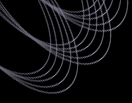
| Home |
| Where to Start |
| About DR6 |
| News and Updates |
| Tutorials |
| Data Products |
| Data Access |
| Sky Coverage |
| Instruments |
| Data Flow |
| Algorithms |
| Glossary |
| Known Problems |
| Help and Feedback |
| Search |
 |
About SEGUEThe Sloan Extension for Galactic Understanding and Exploration (SEGUE) is mining the stellar content of the Milky Way in order to create a detailed 3-dimensional map of the Galaxy. SEGUE will ultimately obtain spectra of 240,000 stars in the disk and spheroid, revealing the age, composition and phase space distribution of stars within the various Galactic components. These stellar excavations will provide essential clues for understanding the structure, formation and evolution of our Galaxy. The SEGUE project, scheduled to run through June 30, 2008, is releasing data to the public as part of SDSS-II DR6. This initial SEGUE data release consists of imaging of approximately 1166 square degree of lower Galactic latitude sky (most with b < 35 degrees), with this SEGUE Imaging Footprint. Additionally, approximately 100,000 SEGUE spectra on 169 plates (with this SEGUE Spectroscopic Footprint) are available. Note that SEGUE obtains its spectroscopic target positions from both the Legacy SDSS Imaging Footprint and the new, lower latitude SEGUE Imaging. SEGUE is not a full sky spectroscopic survey, but rather it sparse-samples the Galaxy in about directions separated by about 10 to 20 degrees on the sky with a pair of spectroscopic plates of area 7 square degrees, obtaining approximately 1100 science spectra toward each of approximately 200 sightlines by survey's end (spectra toward about 80 of these sightlines are available with DR6). We offer a page showing the current status of the SEGUE survey, and a page allowing to browse the 100,000 SEGUE spectra. There is a page describing the science goals of SEGUE and a white paper describing the SEGUE project. New for DR6 is the first release, in SQL searchable database form, of estimates of stellar atmospheric parameters, including metallicity, effective temperature and surface gravity along with radial velocity and stellar classification information for each star. These quantities are tabulated and fully searchable (via SQL) in the sppParams table of the DR6 CAS database. Line indicies for common species are also tabulated for all stars in sppLines. An introduction to the SEGUE spectra is given at http://segue.sdss.org/getstarted.php. There are also notes on the Target Selection for SEGUE. Important note about linking SEGUE imaging and spectra in the CASThe SEGUE spectra count as special-plate spectra in
the CAS and are not considered to be
"scienceprimary". Therefore, they are not linked to the
photometry in the usual way, e.g., they do not appear in the object
browser's default view like galaxy, quasar and stellar spectra from
the legacy survey. Moreover, all SEGUE spectra are in the
Last modified on $Date: 2007/07/12 19:24:45 $ (UT) |